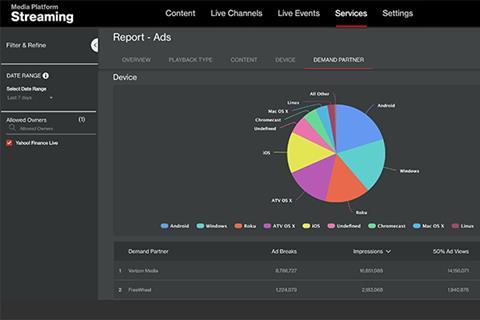Slowly but surely, the advertising industry is switching on to the financial advantages of the cloud to help simplify the delivery of multiple versions of commercials around the world, and to make addressable TV advertising a reality.

It’s no secret that the advertising industry is under pressure.
Global ad spend is set to fall by almost $50 billion – or 8.1% - this year as businesses in all sectors cancel or postpone media buys due to coronavirus, according to the World Advertising Research Center (WARC).
Against such a challenging background, agencies as well as commercial broadcasters, ad-funded streamers and pay-TV operators are urgently looking for ways to cut costs, to streamline commercials production and delivery processes, and to make spot advertising more attractive to brands.
For many, the solution to their problems could lie in the cloud.
The cloud is, of course, transforming the way we all work, with the Covid-19 pandemic leading to a growth in the use of cloud-based services as employees work from home.
However, adoption of the cloud in the advertising and commercials industry varies wildly between organisations. “While some may be a few steps ahead, true end-to-end cloud workflows are not yet commonplace,” says Rowan De Pomerai, head of delivery and growth at business network the DPP, which has been working for the past few months on bringing its work on the Interoperable Master Format (IMF) to bear on advertising workflows.

The advertising workflow is complex and time-consuming, and involves many parties accessing or operating on a piece of content - from the brand and their agency to the broadcaster or online platform, plus those involved in post-production, clearing, compliance, and more. Advertisers are also delivering commercials to more platforms than ever, and in many different formats. And this is often happening on a global level.
Cloud-led workflows have huge potential to simplify this collaboration and workflow.
IMF, in particular, enables a dramatic improvement in the efficiency and flexibility of content mastering, versioning, and localisation. “Yet its use in advertising is highly nascent,” says De Pomerai. The DPP is working with companies like Adstream, Peach, Clearcast, Google, and ITV to explore how IMF might improve the efficiency of producing, storing, clearing, and distributing multivariate commercials.
“True end-to-end cloud workflows are not yet commonplace,” Rowan De Pomerai, DPP
Increasing ROI
One firm offering IMF capabilities is Ownzones, a cloud-based video supply chain firm. Its Ownzones Connect product, says CEO Dan Goman, can deliver higher efficiency, lower costs and increased ROI for advertiser users, specifically around versioning.
During the course of a year, large advertising companies can produce over 100 million versions of content for their customers, says Goman. “The process is highly inefficient - each time there is a new version, they send a link in an email, the customer downloads the content, they view it, and somehow provide feedback. This process takes a long time.”
With Ownzones Connect, the advertiser creates a master IMF package in Connect, their customer can see the product through an app, they provide input through the app, and the input shows up on a timeline in Connect. The ad company editor sees it, makes changes on the timeline, and then a supplemental package is produced.

“The process is quick and efficient,” says Goman, who explains that because IMF is a component-based media format, users can easily swap media elements in and out of a package without having to re-transcode the entire master file. “In an industry like advertising, having maximum flexibility when it comes to localising ads for several different languages and different platform requirements is of the utmost importance.” Doing so in the cloud, he adds, means that users can get high processing power from anywhere in the world, scaling up or down depending on volumes and urgency.
- Read more: Ownzones appoints former Google Cloud COO
The cloud is also powering the ability for brands to deliver personalised, addressable advertising to consumers. Addressable television advertising, in particular, is helping broadcasters to finally go head-to-head with the likes of Facebook and Google by letting them target viewers better.
This, of course, is leading to growing complexity in the advertising workflow – and is an area where the cloud can make processes more efficient.
Global tech firm MediaKind’s cloud-based Prisma product is one solution designed to make addressable ad delivery easier.
Prisma is pitched mainly at broadcasters and pay-TV operators, giving them the ability to offer addressable TV advertising on content offered through digital platforms such as connected TVs, tablets, phones and through set top boxes.
MediaKind director of market development Paul O’Donovan says Prisma can act as an interface between pay-TV operators and broadcasters on the one hand and advertisers on the other. “At a very simple level, it could be that they know I’m 39, in Cambridge and I’m accessing on an iPad. Based on that, they can pull down an advert for, say BMW…Or, if you know someone is a Manchester United fan, and their team is winning, you might want to serve them a very different advert than if their team is losing at half time.”
“In an industry like advertising, having maximum flexibility when it comes to localising ads for several different languages and different platform requirements is of the utmost importance.” Dan Goman, Ownzones
O’Donovan says consumers tend to watch more adverts if these are more engaging and relevant to them, and so the ability to deliver addressable ads can lead to “a hugely increased revenue stream” for broadcasters and operators.
“What this does is give the advertising industry the ability to really bring the digital advertising ecosystem into the TV space,” says O’Donovan.
MediaKind, he says, is currently deploying Prisma with two ‘tier one’ pay-TV operators in Europe at the moment, and with two large public service broadcasters in Europe too.
“The tier one operators and large public broadcasters are all starting to wake up to this because they are starting to see where the revenue can come from,” says O’Donovan. He points to IAB research published May – titled Covid’s Impact on Ad Pricing - which shows that connected TVs have been the most resilient in terms of holding on to ad spend during Covid-19, registering a 6% decline in advertising rates (CPMs) compared to desktop (-27%), smartphone (-28%) and tablet (-29%). One of the reasons is the higher degree of trust consumers have for TV advertising.
The cloud, he adds, is the ‘enabler’ for the Prisma technology. “The cloud gives us the ability for a faster time to market, and that we don’t need to wait for hardware to arrive on premise. It means we can deploy remotely.”

Advertising insertion
The cloud is also powering Verizon Media’s platform, which delivers linear TV channels to OTT devices and has broadcasters such as ESPN, Discovery, Fox and Viacom as clients in North America.
Advertising insertion is one of the core offerings of Verizon Media’s platform. It can insert targeted ads and dynamically switch ads if users are moving through different regions. “Server side ad insertion is the underpinning of our advertising offering,” says Darren Lepke, head of video product management at Verizon Media.
Personalised ads are processed in advance and inserted server-side to help deliver a seamless TV-like experience from content to ads. “When the viewer arrives at a commercial break, the commercial just starts,” says Lepke. “There’s no web-style rebuffering or new player that has to load, or a spinning wheel. If you’re watching a stream at 4K, the ad doesn’t start at 720p and then readjust. It’s a very seamless experience that people have come to expect from television and satellite services everywhere.”
Lepke explains that server side insertion is not just in vogue because it improves the user experience, but also because it is effective at defeating ad blockers. These can recognise the signals from a client device, and know when to turn off the ads. “When you’re stitching the ads up in the cloud, there’s no opportunity for the ad blockers to actually understand what is happening to the device.”
Delivering a seamless ad experience, adds Lepke, results in much higher viewer completion rates of commercials. “So a seamless experience definitely results in higher revenue due to higher completion rates.”
Many within the advertising industry think the possibility of greater efficiency and higher revenues will drive wider adoption of cloud-based technologies.
Perhaps the biggest barrier to cloud adoption, says Ownzones Dan Goman, is the reliance on legacy workflows, “which usually consist of tons of emails, no centralized repositories, and a lack of effective asset management.” The process of migrating a content library and workflows to the cloud can seem daunting, he adds.
“A seamless experience definitely results in higher revenue due to higher completion rates,” Darren Lepke, Verizon Media
That said, Goman notes that cutting edge technology can help differentiate companies from the competition. “Once companies transition to working on cloud-based platforms, the opportunities for advanced workflow automation, shorter delivery timelines, more flexible collaboration, and increased monetisation are endless.”
Says Goman: “Technology is, in many cases, the deciding factor for potential customers.”
The coronavirus pandemic is also likely to have an impact. The advertising industry has, like all others, needed to increase remote working during the pandemic. “And that’s doubtless led to a growth in the use of cloud based services,” says the DPP’s De Pomerai.
However, he thinks the dramatic downturn in advertising revenue this year is having a corresponding effect on the budgets which might be spent on technical transformation in the advertising supply chain.
“So while interest is certainly there, it’s fair to say we see a slowing of investment in the short term,” says De Pomerai, who adds that this is likely to rebound as the world builds back from the pandemic. “As with most media companies, advertisers and agencies will have a renewed appreciation for the benefits of the kind of flexible, scalable, resilient, location-independent infrastructure that the cloud can provide.”
- Read more: Looking to the cloud during lockdown



























No comments yet